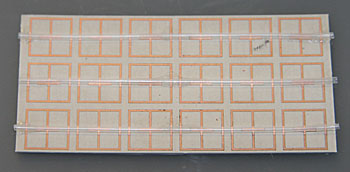The National Institute of Standards and Technology (NIST) researchers have developed a special fluid-tuned metasurface, which can be used in microwave-assisted chemistry and biomedical sensors. A metasurface, also called a metafilm is a two-dimensional metamaterial structure, popularly implemented in technologies that have unnatural properties, for example the illusion of invisibility.
 NIST's fluid-tunable metasurface consists of copper structures and plastic tubing mounted on composite board
NIST's fluid-tunable metasurface consists of copper structures and plastic tubing mounted on composite board
Metamaterials have a novel structure and hence feature unique properties that are not present in nature. NIST's metasurface is a tiny part of a composite circuit board covered with patches of metal in specific arrangements and shapes. The resultant structure will be capable of storing, reflecting or transmitting energy.
NIST researchers could tune the resonant frequency of the metasurface using purified water. At this frequency, the surface has the capacity to accumulate energy. Researchers determined that the metasurface could be used to exert electric fields in a localized area. They also found that the metasurface could be used to heat fluids, which allows microwave-assisted biochemical or chemical reactions to take place.
The metasurface has 18 square copper frame formations each measuring 10mm that interact with each other and are responsible for affecting the metasurface's behavior. Researchers generate simulations using the computer to enable the copper structures to react to a particular frequency. Using microwaves, these copper structures can be immediately excited. When the metasurface is present in a resonant state, each structure can accumulate energy within a T-shaped space present in its midsection. The space is bonded using fluid channels manufactured from plastic tubes. The sample is positioned in a waveguide, which functions like a kaleidoscope and directs the microwaves. The waveguide has walls that act as mirrors. It presents the electrical illusion that the metasurface reaches infinity.
The metasurface properties were evaluated both in the presence and absence of purified water in the fluid channels. The resonant frequency varied from 3.75 to 3.60 GHz with water. The metasurface transmits or reflects energy at all other frequencies. When the metasurface was in the resonant state, it could focus 100 times more energy in the gaps than when placed in the waveguide alone. NIST researchers hope to make metamaterial circuits or chips for use in biomedical applications such as cell counting.